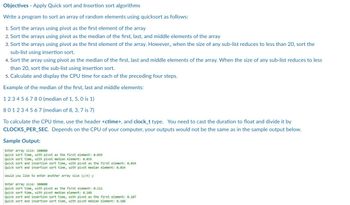
Database System Concepts
7th Edition
ISBN: 9780078022159
Author: Abraham Silberschatz Professor, Henry F. Korth, S. Sudarshan
Publisher: McGraw-Hill Education
expand_more
expand_more
format_list_bulleted
Question
In c++

Transcribed Image Text:Objectives - Apply Quick sort and Insertion sort algorithms
Write a program to sort an array of random elements using quicksort as follows:
1. Sort the arrays using pivot as the first element of the array
2. Sort the arrays using pivot as the median of the first, last, and middle elements of the array
3. Sort the arrays using pivot as the first element of the array. However,, when the size of any sub-list reduces to less than 20, sort the
sub-list using insertion sort.
4. Sort the array using pivot as the median of the first, last and middle elements of the array. When the size of any sub-list reduces to less
than 20, sort the sub-list using insertion sort.
5. Calculate and display the CPU time for each of the preceding four steps.
Example of the median of the first, last and middle elements:
123456780 (median of 1, 5,0 is 1)
801234567 (median of 8, 3, 7 is 7)
To calculate the CPU time, use the header <ctime>, and clock_t type. You need to cast the duration to float and divide it by
CLOCKS_PER_SEC. Depends on the CPU of your computer, your outputs would not be the same as in the sample output below.
Sample Output:
Enter array size: 100000
Quick sort time, with pivot as the first element: 0.039
Quick sort time, with pivot median element: 0.035
Quick sort and insertion sort time, with pivot as the first element: 0.034
Quick sort and insertion sort time, with pivot median element: 0.034
Would you like to enter another array size (y/n) y
Enter array size: 300000
Quick sort time, with pivot as the first element: 0.111
Quick sort time, with pivot median element: 0.108
Quick sort and insertion sort time, with pivot as the first element: 0.107
Quick sort and insertion sort time, with pivot median element: 0.108
Expert Solution
This question has been solved!
Explore an expertly crafted, step-by-step solution for a thorough understanding of key concepts.
This is a popular solution
Trending nowThis is a popular solution!
Step by stepSolved in 2 steps

Knowledge Booster
Learn more about
Need a deep-dive on the concept behind this application? Look no further. Learn more about this topic, computer-science and related others by exploring similar questions and additional content below.Similar questions
arrow_back_ios
arrow_forward_ios
Recommended textbooks for you
 Database System ConceptsComputer ScienceISBN:9780078022159Author:Abraham Silberschatz Professor, Henry F. Korth, S. SudarshanPublisher:McGraw-Hill Education
Database System ConceptsComputer ScienceISBN:9780078022159Author:Abraham Silberschatz Professor, Henry F. Korth, S. SudarshanPublisher:McGraw-Hill Education Starting Out with Python (4th Edition)Computer ScienceISBN:9780134444321Author:Tony GaddisPublisher:PEARSON
Starting Out with Python (4th Edition)Computer ScienceISBN:9780134444321Author:Tony GaddisPublisher:PEARSON Digital Fundamentals (11th Edition)Computer ScienceISBN:9780132737968Author:Thomas L. FloydPublisher:PEARSON
Digital Fundamentals (11th Edition)Computer ScienceISBN:9780132737968Author:Thomas L. FloydPublisher:PEARSON C How to Program (8th Edition)Computer ScienceISBN:9780133976892Author:Paul J. Deitel, Harvey DeitelPublisher:PEARSON
C How to Program (8th Edition)Computer ScienceISBN:9780133976892Author:Paul J. Deitel, Harvey DeitelPublisher:PEARSON Database Systems: Design, Implementation, & Manag...Computer ScienceISBN:9781337627900Author:Carlos Coronel, Steven MorrisPublisher:Cengage Learning
Database Systems: Design, Implementation, & Manag...Computer ScienceISBN:9781337627900Author:Carlos Coronel, Steven MorrisPublisher:Cengage Learning Programmable Logic ControllersComputer ScienceISBN:9780073373843Author:Frank D. PetruzellaPublisher:McGraw-Hill Education
Programmable Logic ControllersComputer ScienceISBN:9780073373843Author:Frank D. PetruzellaPublisher:McGraw-Hill Education

Database System Concepts
Computer Science
ISBN:9780078022159
Author:Abraham Silberschatz Professor, Henry F. Korth, S. Sudarshan
Publisher:McGraw-Hill Education

Starting Out with Python (4th Edition)
Computer Science
ISBN:9780134444321
Author:Tony Gaddis
Publisher:PEARSON

Digital Fundamentals (11th Edition)
Computer Science
ISBN:9780132737968
Author:Thomas L. Floyd
Publisher:PEARSON

C How to Program (8th Edition)
Computer Science
ISBN:9780133976892
Author:Paul J. Deitel, Harvey Deitel
Publisher:PEARSON

Database Systems: Design, Implementation, & Manag...
Computer Science
ISBN:9781337627900
Author:Carlos Coronel, Steven Morris
Publisher:Cengage Learning

Programmable Logic Controllers
Computer Science
ISBN:9780073373843
Author:Frank D. Petruzella
Publisher:McGraw-Hill Education